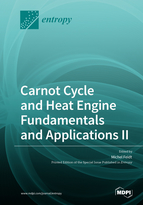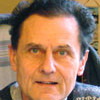Carnot Cycle and Heat Engine Fundamentals and Applications II
A special issue of Entropy (ISSN 1099-4300). This special issue belongs to the section "Thermodynamics".
Deadline for manuscript submissions: closed (30 June 2021) | Viewed by 22608
Special Issue Editor
Interests: thermodynamics; energy; transfers; conversion
Special Issues, Collections and Topics in MDPI journals
Special Issue Information
Dear Colleagues,
Engineering and theoretical thermodynamics has been ripe for improvement, particularly since the sixties.
Regarding phenomenological thermodynamics, a first step was the consideration of endoreversible engines and reverse corresponding configurations. These phenomenological approaches are currently being improved through the consideration of dissipative mechanisms, in order to represent more precisely the global performance of the system, with more and more complex systems being considered—such as cascades and co- or trigeneration.
To optimize systems and processes, we first need to clearly define the objectives and constraints applied to them. The efficiency concept plays a central role in that. Three main aspects are related to particular fundamental or engineering situations:
- Fundamental physical criteria;
- Environmental concern;
- Economic concern.
Our first Special Issue on this topic examined the state-of-the-art of these aspects. What we propose here is to continue to explore the improvement of these approaches related to engines but also reverse cycle machines.
Additionally, it appears that these mesoscale studies are completed now with the use of nanoscale (quantum engines) as well as megastructures (implications in cosmology). Thus, it could be useful to correlate and compare all these options, which is another goal of this second Special Issue.
Prof. Dr. Michel Feidt
Guest Editor
Manuscript Submission Information
Manuscripts should be submitted online at www.mdpi.com by registering and logging in to this website. Once you are registered, click here to go to the submission form. Manuscripts can be submitted until the deadline. All submissions that pass pre-check are peer-reviewed. Accepted papers will be published continuously in the journal (as soon as accepted) and will be listed together on the special issue website. Research articles, review articles as well as short communications are invited. For planned papers, a title and short abstract (about 100 words) can be sent to the Editorial Office for announcement on this website.
Submitted manuscripts should not have been published previously, nor be under consideration for publication elsewhere (except conference proceedings papers). All manuscripts are thoroughly refereed through a single-blind peer-review process. A guide for authors and other relevant information for submission of manuscripts is available on the Instructions for Authors page. Entropy is an international peer-reviewed open access monthly journal published by MDPI.
Please visit the Instructions for Authors page before submitting a manuscript. The Article Processing Charge (APC) for publication in this open access journal is 2600 CHF (Swiss Francs). Submitted papers should be well formatted and use good English. Authors may use MDPI's English editing service prior to publication or during author revisions.
Keywords
- Carnot engine
- Stochastic engine
- Quantum engine
- Reverse cycle machines
- Optimization
- Finite time thermodynamics
- Finite speed thermodynamics
- Finite physical dimension thermodynamics







